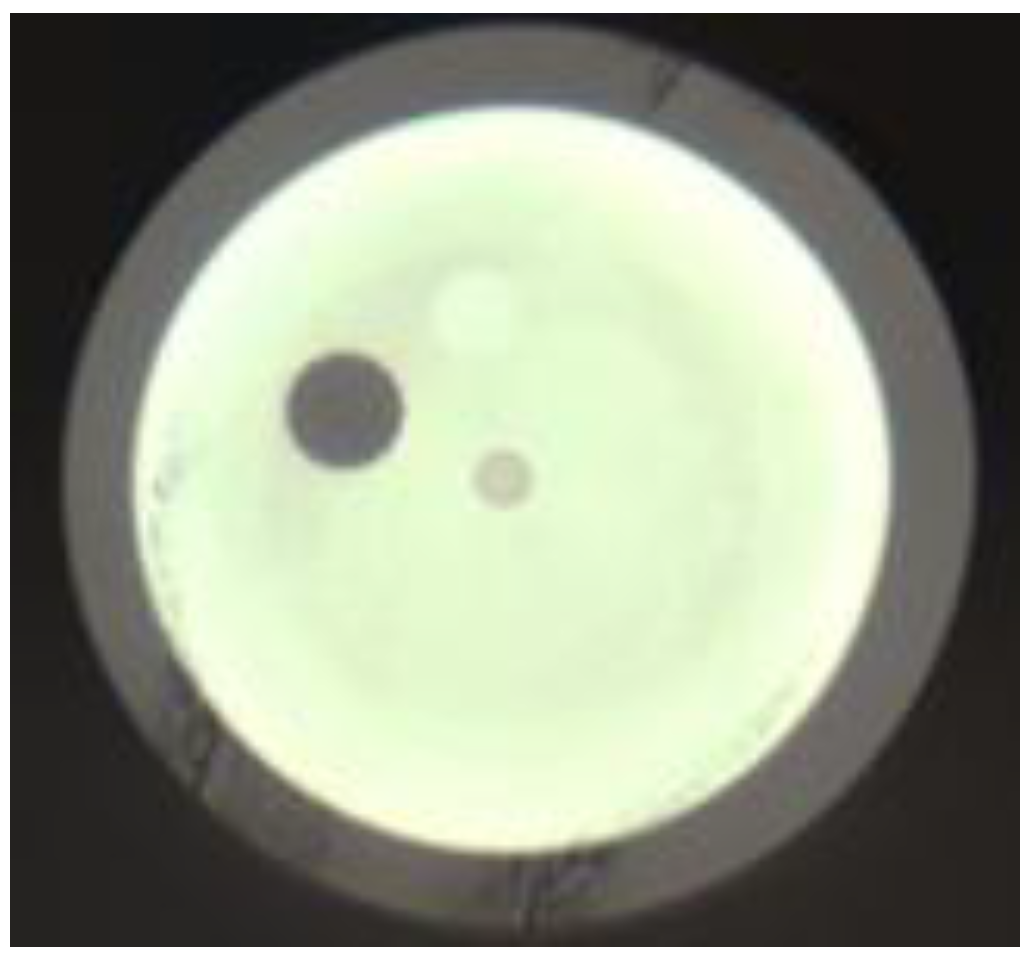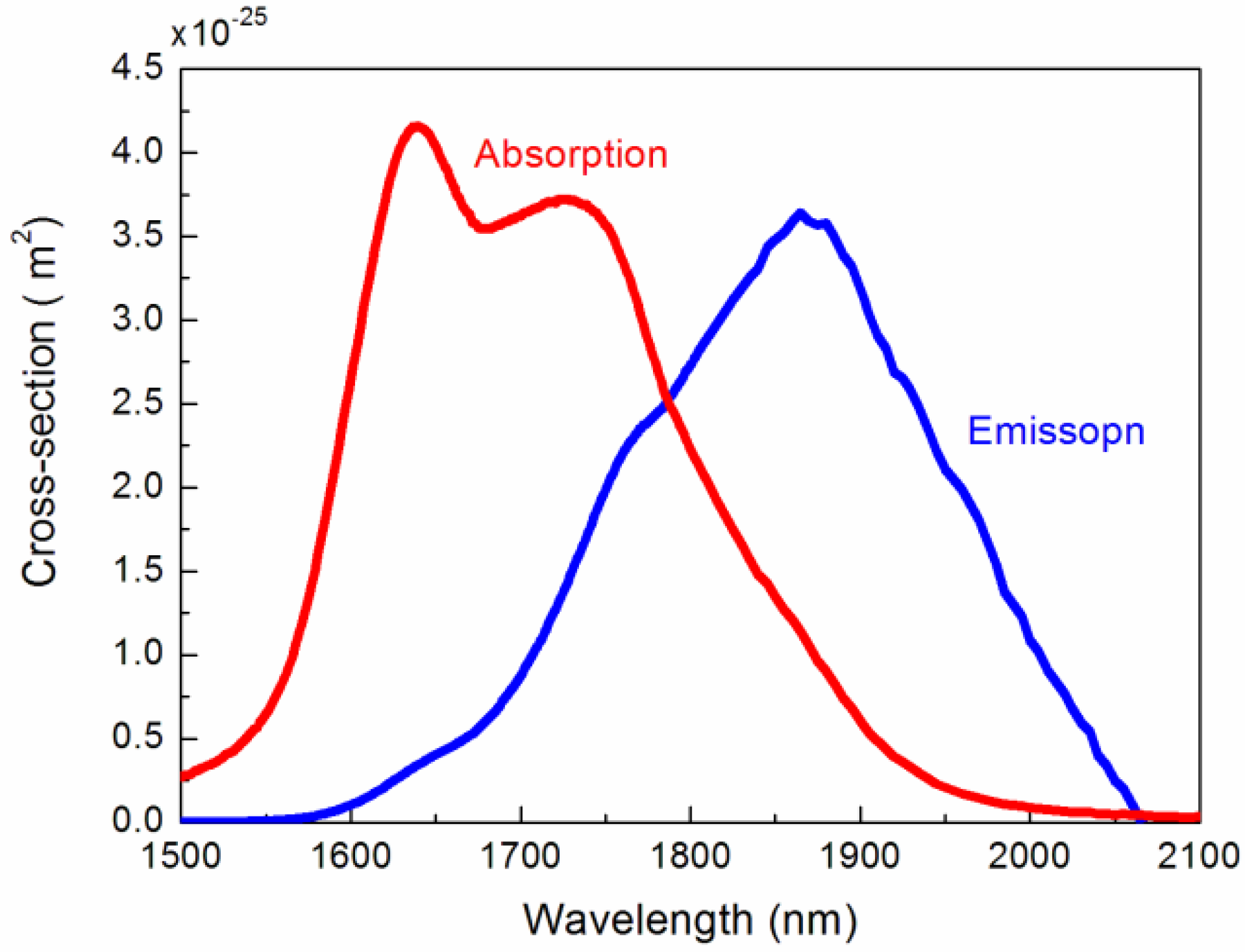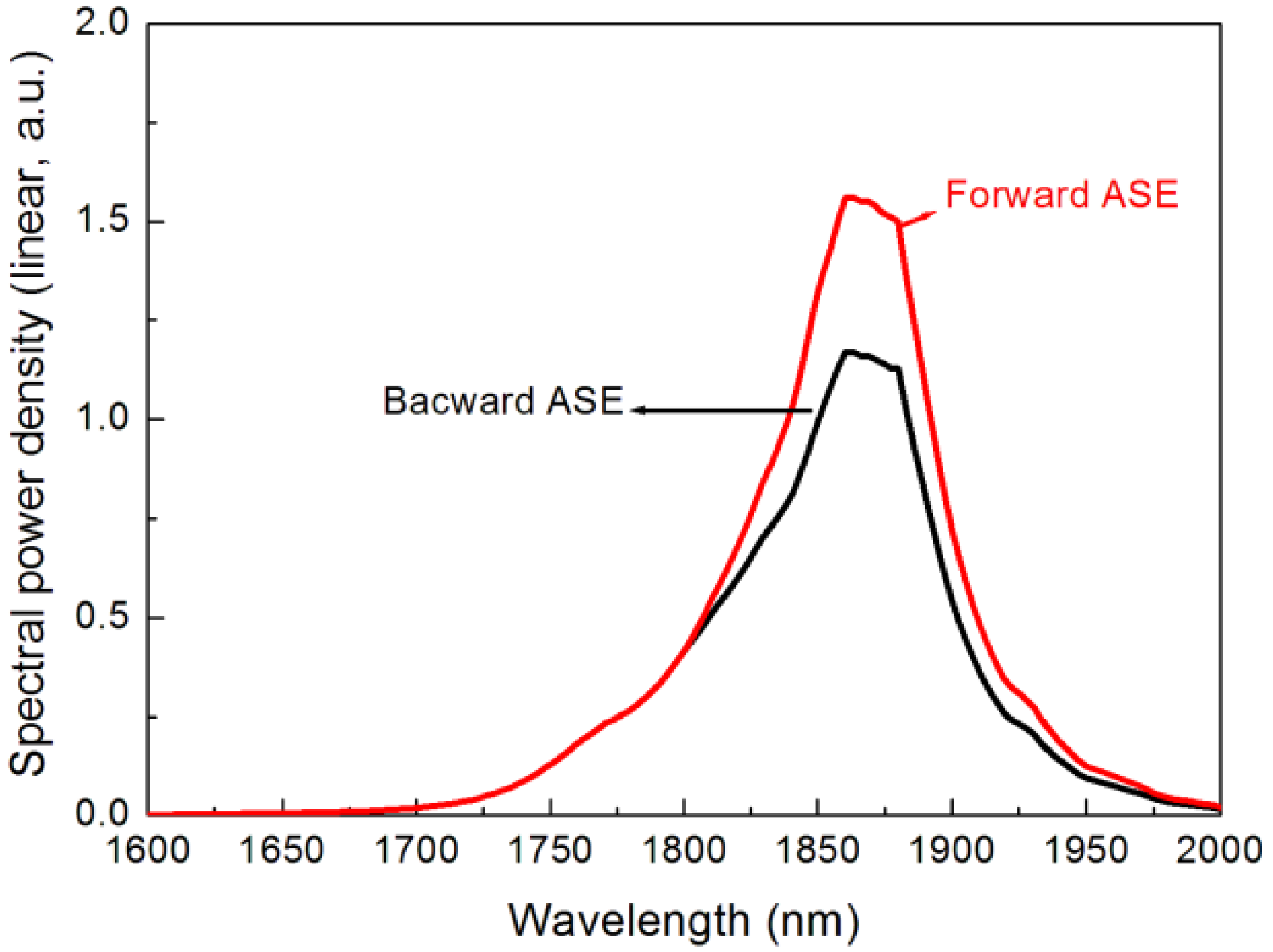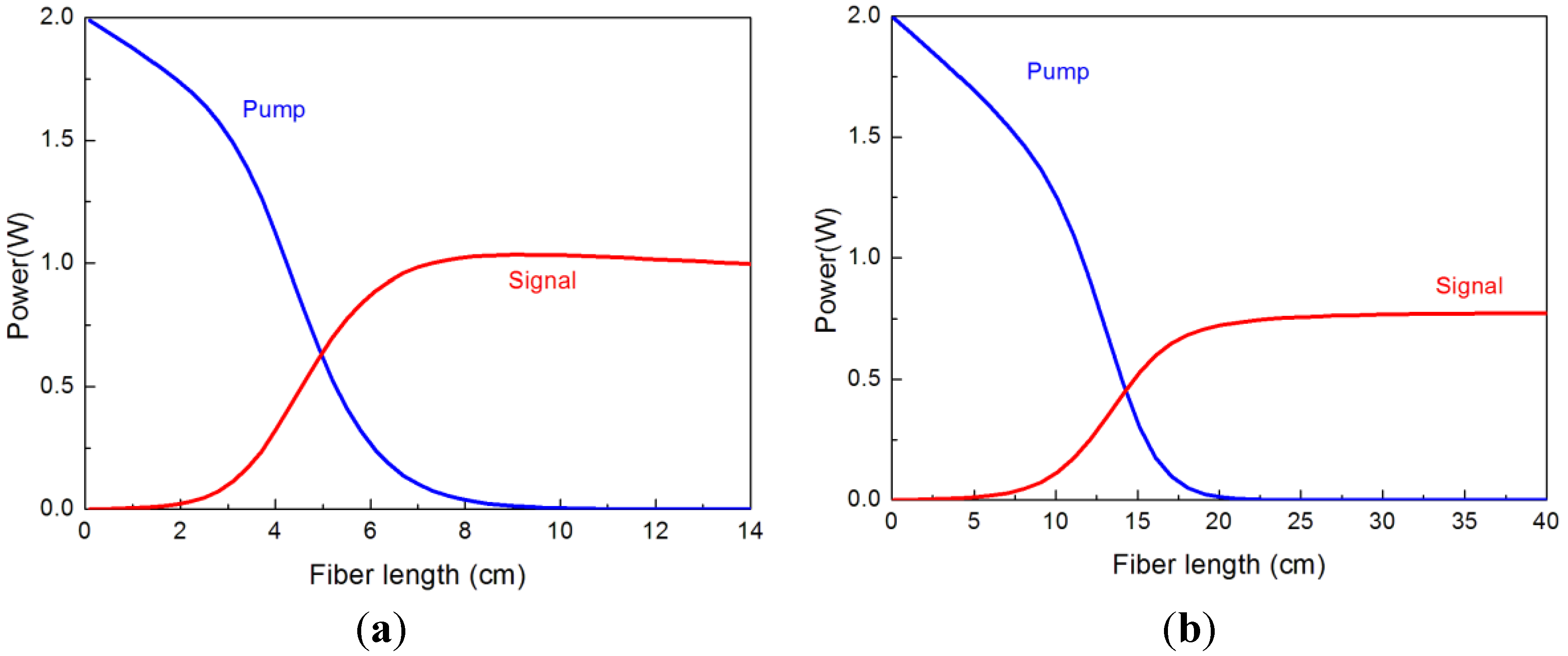1. Introduction
Ultrafast laser sources in the 2-μm eye-safe region are of interest for many applications, such as frequency comb metrology, environmental sensing, eye-safe LIDAR, space communication, medical surgery, particle accelerators, and light sources for efficient mid-IR generation. To produce 2-μm laser emission in fibers, Tm
3+ is a favorable ion because it offers high quantum efficiency, broad gain bandwidth, and strong absorption band around 800 nm, the wavelength available from commercial high-power diode lasers. Through the “two-for-one” cross-relaxation energy transfer, more than 70% slope efficiency has been reported in a 790-nm pumped Tm
3+-doped fiber laser [
1]. In addition, the broad gain bandwidth from 1.8 µm to 2.1 µm allows a large wavelength tuning range and makes Tm
3+-doped fiber a suitable gain medium for generation of femtosecond pulses. In recent years, the output power from Tm
3+-doped fiber lasers and amplifiers have been scaled to well above the kilowatt level. One approach for further power scaling these light sources is to increase the Tm
3+ concentration to reduce the required fiber length, and thus avoid detrimental nonlinear effects. More importantly, the high Tm
3+ concentration enables the efficient cross-relaxation processes leading to high quantum efficiencies. The minimum Tm
3+ concentration to generate efficient cross-relaxation process is known to be around 3wt%. Unfortunately, this doping level is hard to achieve in a silica fiber because excessive amounts of Tm
3+ in silica fibers may cause concentration quenching and photodarkening. Therefore, most current Tm
3+-doped silica fibers employed in mode-locked fiber lasers have concentrations below 2 wt%, leading to the long required length of gain fibers. Such a meter-long cavity length limits the repetition rate of a mode-locked laser to multi-megahertz level.
Fabricating highly Tm
3+-doped fibers has been an active subject in the field of 2-µm fiber lasers. Several glass hosts, such as germanate, tellurite, and silicate, have been intensely studied. In 2007, Wu
et al. successfully demonstrated a 106-W germanate fiber laser with 5 wt% of the Tm
2O
3 concentration [
2]. Although this result makes the germanate fiber a promising gain medium for high-power 2-µm generation, the germanate fiber tends to have low photodarkening resistance and low compatibility with passive silica fibers, which makes it difficult to build an all-fiber laser system. On the other hand, an efficient 2-µm tellurite fiber laser has been reported; however, the presented Tm
3+ concentration is relatively low and the fiber background loss is too high [
3]. A good alternative approach reported here is using multi-component silicate glass as the fiber host. Compared with silica glass, the multi-component silicate glass has less-defined glass network, which provides much higher Tm
2O
3 solubility. It is believed the multi-component silicate fibers can be doped with more than 10 wt% of Tm
2O
3. Such high solubility allows for considerably shorter fiber lengths, which are beneficial for the mitigation of nonlinear effects, high pulse repetition rates, and efficient two-for-one cross-relaxation processes. Furthermore, different from germanate and tellurite glasses, the main glass network of the silicate fiber is SiO
2, which leads to much stronger mechanical strength and better compatibility with conventional passive silica fibers.
The first cw and Q-switched Tm
3+-doped silicate fiber lasers were successfully built by Geng
et al. in 2009 [
4,
5]. Following this research, an all-fiber passively mode-locked laser system based on highly Tm
3+-doped silicate fiber was also demonstrated [
6]. All of these promising results were achieved in Tm
3+-doped silicate fibers with the concentration less than 5wt%. We report in this paper our latest progress in silicate fiber fabrication as well as the simulation and testing of Tm
3+-doped silicate fiber amplifier with one of the highest published concentrations (8.35 × 10
20/cm
3) for a Tm
3+-doped fiber.
2. Material Properties of Tm3+ Doped Silicate Fiber
The preforms of the Tm3+-doped used in this paper were made of alkaline-earth silicate glasses. The glass included SiO2, A12O3, BaO, ZnO, and La2O3. Al2O3 was added to ensure high mechanical strength and good chemical durability. Transition metals such as Fe and Cu, as well as and alkali ions, were eliminated to further enhance the glass properties.
A photograph of the cleaved fiber end is shown in
Figure 1. The fiber has a double-clad structure with a 152 μm circular outer cladding, a 125 μm circular inner cladding with a NA of 0.617, and a 10 μm circular core with a NA of 0.149 that is single mode at wavelengths above 1550 nm. A low-index rod was inserted inside the inner cladding to provide cladding mode mixing and improve spatial overlap between the pump modes and doped core. It has been shown in [
6] that the added low-index rod increases the pump absorption in the doped core. Since it is easier to manipulate the refractive index of this multi-component glass than silica, the outer cladding of double-clad silicate fibers can also be made of silicate glass. This is important because the thermal properties of the glass outer cladding are far superior to the properties of the polymers widely used as outer claddings in double-clad silica fibers. The fiber was jacketed with low-index polymer for the protection from rugged environments. The fiber parameters are listed in
Table 1.
Figure 1.
Photograph of the cleaved Tm3+-doped silicate fiber.
Figure 1.
Photograph of the cleaved Tm3+-doped silicate fiber.
Table 1.
Fiber parameters.
Table 1.
Fiber parameters.
| | Diameter (um) | Refractive index | NA |
|---|
| Active core | 10 | 1.64 | 0.149 |
| Low-index rod | 20 | 1.506 | |
| Inner cladding | 125 | 1.623 | 0.617 |
| Outer cladding | 152 | 1.513 | |
The silicate fiber was manufactured at Advalue Photonics by the rod-in-tube technique. This technology is commonly used for producing fibers made of multi-component glasses such as fluorozirconate and silicate-based fibers with multi-component glass core compositions. The main reason is that some of the chemicals required to fabricate silicate fibers cannot be volatilized. A core glass rod and two cladding tubes were fabricated and assembled to form the fiber preform. The core rod was cored out of a larger bulk sample with a diamond-embedded core drill, and subsequently polished. Both the inside and outside surfaces of the glass tubes for the inner and outer claddings were polished to a high surface quality. The inside diameter of the inner-cladding tube was matched to the diameter of the core rod, and the inside diameter of the outer-cladding tube is matched to the outer diameter of the inner-cladding tube. Both core and cladding glasses were carefully prepared to ensure that their chemical and thermo-mechanical characteristics are compatible, especially their softening temperature and thermal expansion coefficient. The fiber was drawn in a special furnace optimized for non-silica glasses. One important advantage of fabricating double-clad fibers by using the rod-in-tube method is that one can control the refractive indices of the fiber core and inner-cladding glasses precisely and independently.
The propagation loss was measured using the cut-back method in a 150-cm-long silicate fiber doped with 7 wt% of Tm2O3. A 250-mW, 976-nm probe laser was coupled into the fiber core under fixed launching conditions, and the residual output power was repeatedly measured after gradually cutting back the fiber sample. The wavelength of the probe laser was chosen to be outside of the Tm3+ absorption band. The propagation loss and a lunched laser power were inferred from an exponential fit to the measured residual power as a function of the fiber length. The measured propagation loss was 0.7 dB/m.
The glass host composition affects the solubility of the rare-earth dopant which, in turn, may affect the fluorescence lifetime, absorption, emission, and excited-state absorption cross-sections of the dopant transitions. To obtain a reliable theoretical prediction of the performance of the silicate fiber laser sources, we need to know the spectroscopic properties accurately, especially the emission and absorption cross-sections. These properties were measured in bulk silicate glass samples with the same chemical composition and Tm3+-concentration as the Tm3+-doped silicate fiber core.
The absorption cross-sections were obtained from the measured white-light absorption spectrum of the sample. The spectral shape of the emission was obtained from the measured fluorescence spectrum of a thin silicate glass plate, pumped at 793 nm near one of its edges. The emitted fluorescence was collected from the thin side of the sample. Possible re-absorption of the signal, which might have distorted the measured fluorescence spectrum, was avoided by keeping the sample thin enough.
Figure 2 shows the measured cross-section spectra for absorption and emission of Tm
3+ in the silicate glass host. The absorption and emission peaks are located at 1640 nm and 1865 nm, respectively. The maximum absorption cross-section is measured to be 4.16 × 10
−25 m
2. The absolute scaling of the emission cross-section is determined by applying the McCumber method to the measured peak absorption cross-section [
7]. The calculated peak emission cross-section is 3.59 × 10
−25 m
2. Although this method has been shown to be rather inaccurate when precise cross-section values are required [
8], it provides a convenient estimate for the calibration of the measured fluorescence spectrum. As shown in
Figure 2, the spectra of Tm
3+ ions in silicate glass are fairly similar to the spectra in silica glass [
9], except for the larger emission cross-sections in the long-wavelength region.
Figure 2.
Measured absorption and emission cross-section spectra of the Tm3+-doped silicate fiber.
Figure 2.
Measured absorption and emission cross-section spectra of the Tm3+-doped silicate fiber.
The fluorescence lifetime of the 7-wt% Tm3+-doped silicate glass was measured to be 0.635 ms. This value is similar to the Tm3+ lifetime in low Tm3+-doped silicate glass fibers. The measured fluorescence relaxation curve showed a single exponential decay, thus demonstrating negligible concentration quenching in spite of the high Tm3+ concentrations.
4. Experimental Demonstration of 793-nm Cladding-Pumped Tm3+-Doped Silicate Fiber Amplifier
To provide an experimental validation of the silicate fiber amplifier operation, we developed a 793-nm cladding-pumped Tm
3+-doped silicate fiber MOPA. The experimental setup is shown in
Figure 5. It is a ring-cavity 2013-nm Tm
3+-doped silicate fiber laser, followed by a Tm
3+-doped silicate fiber amplifier. The aforementioned 7 wt% Tm
3+-doped silicate fibers were employed in both the fiber oscillator and amplifier. Without the use of wavelength selection devices, the laser was naturally operated at 2013 nm with the maximum output power of 17.8 mW and slope efficiency of 15.9 %. The 2013-nm seed laser was then amplified by another 50-cm 7 wt% Tm
3+-doped silicate fiber with the signal input power of 472.5 μW.
Figure 5.
Experimental Tm3+-doped silicate fiber amplifier.
Figure 5.
Experimental Tm3+-doped silicate fiber amplifier.
Figure 6 shows the measured signal gain as a function of launched pump power. A maximum gain of 18.2 dB with respect to the launched signal power was reached at an absorbed pump power of 460 mW (885 mW launched). The corresponding 2013-nm signal gain-per-unit-length of this amplifier was 0.54 dB/cm. Because of the 2 times larger emission cross-section at 1950 nm, the signal gain at 1950 nm could be much higher than that at 2013 nm under the same pump power. As shown in
Figure 6, there is no sign of signal gain saturation, and the maximum signal gain is limited by the available pump power. The 793-nm cladding absorption coefficient of this silicate fiber was measured as ~5.18 dB/m. It means a fiber length of 2 m would be needed to provide sufficient pump absorption and further increase the signal gain. The measured output spectrum of the fiber amplifier measured at 18.2 mW is shown in the inset of
Figure 6.
Figure 6.
Experimental Tm3+-doped silicate fiber amplifier.
Figure 6.
Experimental Tm3+-doped silicate fiber amplifier.
5. Photodarkening Measurement of Tm3+-Doped Silicate Fiber
A measurement method providing an application-independent quantification of photodarkening in fibers has been proposed by Koponen
et al. [
14]. In this method, a visible probe laser is used to measure the transmission of the pumped active fiber. The photodarkening-induced loss of silica or silicate fibers at the probe wavelength is then estimated from the measured reduction in transmission. UV-induced color centers in the silica or silicate fibers have an absorption peak at 500 nm and the tail of this absorption line extends to the NIR [
15]. In this experiment, we aim to measure the application-independent photodarkening resistance of the Tm
3+-doped silicate fibers, namely, the maximum Tm
3+ concentrations allowed in the fibers before the onset of photodarkening.
The experimental setup for the photodarkening test in silicate fibers is shown in
Figure 7. The employed fiber sample was a 7-cm Tm
3+-doped silicate fiber with a 10-μm core and 125-μm cladding. To get a significant population inversion, the fiber sample was core-pumped by a 1550-nm laser with a 400-mW output power. A 976-nm probe laser was also coupled into the fiber through a WDM fiber coupler to periodically measure the photodarkening-induced reduction in fiber transmission. The 976-nm laser was chosen to separate the attenuation effects coming from original Tm
3+-absorption and photodarkening. Both the 1550-nm pump and 976-nm probe lasers were temperature/wavelength stabilized with long-term power fluctuations of less than 1%. The test fiber was spliced to the WDMs and the whole optical system was well isolated from possible mechanical shocks in the lab environment and thus assured stability during the measurements.
Figure 7.
Photodarkening measurement setup.
Figure 7.
Photodarkening measurement setup.
The population inversion along the fiber sample is simulated and shown in
Figure 8. The result indicates >45% average population inversion along the whole fiber sample.
Figure 9 shows the normalized 976-nm transmission of the silicate fiber samples measured as a function of exposure time. After pumping for over 10,000 min, no sign of photodarkening was observed. Because no onset of photodarkening can be obtained in this fiber sample under such high population inversion conditions, the fiber should be immune to photodarkening when used in most laser systems.
Figure 8.
The population inversion along the 7-cm Tm3+-doped silicate fiber.
Figure 8.
The population inversion along the 7-cm Tm3+-doped silicate fiber.
Figure 9.
Measured normalized transmission of the silicate fiber at 976 nm as a function of pump exposure time.
Figure 9.
Measured normalized transmission of the silicate fiber at 976 nm as a function of pump exposure time.













